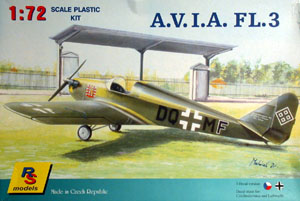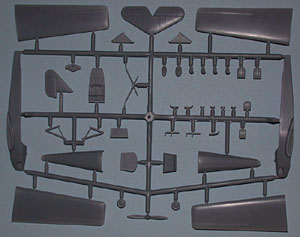RS Models' 1/72 A.V.I.A. FL.3 |  | History Not to be confused with Avia, the Czech aviation company, A.V.I.A. was actually an Italian firm started in 1938. Based out of Vercelli, the company decided on a two-seat light training/touring aircraft for its first production type. Initially powered by a 45hp Czech Persy II engine, the Italian Air Ministry selected it as a perfect low-cost airframe for use in Italian Aero Clubs. Production versions differed from the original with a new engine, this time a 60hp CNA D/IVS engine. With this final design change the type came to be known as the FL.3 and 355 were built. Twenty of these found their way into the Croatian Air Force, while approximately 250 were interned by Germany during the Second World War. After the war the plane continued flying with aero clubs in Switzerland, Italy and Czechoslovakia. The Kit While this plane may not be at the top of everyone's 'Gotta Have!' list, it is an interesting subject and the RS Model kit is very well done. You get one sprue of gray injection-molded parts, two vacuformed windscreens, and a small decal sheet. The plastic parts are very well molded, with very nice detailing both internally and externally. You get a pair of rear turtledecks, two choices for seat backs, and two choices of landing gear. The instructions only outline the usage of one set of these parts, so additional research will be needed if you want to build one of these alternate versions.  Looking at the interior, you get a cockpit floor with the seat bases molded in place. The seat cushions are well done, and there's a couple small holes for the control sticks. The sticks themselves, often a problem with limited run kits, are nicely done and will only need a little cleanup around the edges. The seat backs for this specific version are hollow (the alternate ones are cushions), and the only thing that's really needed here are seat belts. The instrument panel has recesses for the instruments (but no actual instrument faces), making it a bit easier to fill with Future or epoxy to simulate the glass. Looking at the interior, you get a cockpit floor with the seat bases molded in place. The seat cushions are well done, and there's a couple small holes for the control sticks. The sticks themselves, often a problem with limited run kits, are nicely done and will only need a little cleanup around the edges. The seat backs for this specific version are hollow (the alternate ones are cushions), and the only thing that's really needed here are seat belts. The instrument panel has recesses for the instruments (but no actual instrument faces), making it a bit easier to fill with Future or epoxy to simulate the glass.
The fuselage sides have fine sidewall detailing that will really show up well once painted. The separately molded turtledeck is a wise choice, as it eliminates the seam down the top. With a bit of care and dryfitting beforehand, the fuselage assembly could easily be filler-free. Onto the fuselage fits the one-piece stabilizer and one-piece fin. The final assembly to fit in the fuselage is the engine, which is made up of separate cylinders fitting into an opening on each side of the nose. Separate exhaust pipes are also provided.  Moving to the underside of the plane, the landing gear is fairly simple, with two V struts fitting to the wing roots and an X brace fitting between them. These parts are all very finely molded and almost look too frail for the finished model, but like the real thing the bracing adds strength and there should be no problems in supporting the kit. The final step is with the wings, which are split into upper and lower halves and are butt-joined to the fuselage. Moving to the underside of the plane, the landing gear is fairly simple, with two V struts fitting to the wing roots and an X brace fitting between them. These parts are all very finely molded and almost look too frail for the finished model, but like the real thing the bracing adds strength and there should be no problems in supporting the kit. The final step is with the wings, which are split into upper and lower halves and are butt-joined to the fuselage.
The decals offer a total of three choices, two Luftwaffe and one Czech. The first Luftwaffe example is that seen on the boxtop, finished in RLM 71 over RLM 65. The second example is a bit wilder, being RLM 75 or RLM 76, with RLM 74 squiggles all over the upper surfaces. The third choice is a civil-registered Czech example, finished in overall gray-green. Conclusion If you want something small and different, grab this kit. The nice moldings should make for a quick build, and the interesting lines and choice of markings will guarantee some interesting comments from fellow modelers. | 

 



|
